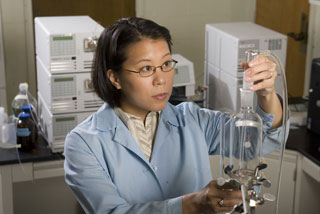It seems that natural organic matter, found in water and silt, plays a central role in helping bacteria convert tiny mercury particles in the environment into a chemical form that is dangerous to most living things.

It seems that natural organic matter, found in water and silt, plays a central role in helping bacteria convert tiny mercury particles in the environment into a chemical form that is dangerous to most living things.
This finding is important, claim environmental engineers from Duke University, because it may change the method by which mercury levels are measured (The term mercury in Wikipedia) in the environment, a method following which it is decided how to act on this issue. This harmful form of the substance, known by the scientific name methylmercury, is a possible neurotoxin. When bees feed on food containing this form, the substance is not excreted, but accumulates to dangerous levels in the various tissues and organs.
Researchers from the Department of Environmental and Civil Engineering at Duke University found in a series of laboratory experiments that organic matter and chemical compounds containing sulfur (sulfides) are able to bind easily to form mercury-sulfide nanoparticles. Since they are much more soluble than larger particles, it is possible that these nanoparticles are the starting materials of the methylation process, which leads to obtaining the dangerous form of the substance.
"When the organic matter reacts with the mercury, it prevents it from continuing to react with additional mercury particles and reaching larger dimensions as a result," explains one of the researchers.
"Since the mercury remains in nanoparticle size, it easily accumulates on the surface of the bacteria, where any form of soluble mercury penetrates the interior of the bacteria," explains the researcher. "In the absence of the organic material, the mercury-sulfide nanoparticles would have grown more and more and at a certain point become insoluble and thus their ability to penetrate the bacteria and accumulate inside them as a dangerous chemical form would have decreased." Only during its presence inside the bacteria does the mercury become the harmful form as methylmercury, the researchers explain.
These reactions can only occur in cold water environments where the amount of oxygen is zero or minimal, such as in alluvial areas located just below bodies of water. Such similar anaerobic environments are also found in wastewater and wastewater treatment systems, the researchers note.
"The exposure rate of mercury in the US is quite high," said scientist Heileen Hsu-Kim, a professor of civil and environmental engineering at Duke University and one of the authors of the study. "In a recent epidemiological survey, it was found that eight percent of women have mercury levels that are higher than the recommended national standard. Since humans are at the top of the food chain, all the mercury in our food will eventually accumulate in our bodies."
Since fish and shellfish have a natural tendency to accumulate methylmercury in their organs, they are the main source of mercury digestion for humans. Mercury is highly toxic and can lead to kidney dysfunction, neurological deficits and even death. In particular, fetuses exposed to methylmercury may suffer from these diseases as well as various learning disabilities.
There are many ways in which mercury enters the environment, with the main sources being the burning of coal, the purification of metals such as gold, and the gases emitted during volcanic eruptions. Airborne mercury from these sources eventually ends up in lakes and other bodies of water and can remain there in the water or in silt.
"These preliminary laboratory findings can have far-reaching consequences," claims the researcher. "The finding that these reactions can occur in airless environments suggests that the existing method for examining toxic metals in driftwood provides incomplete information about the levels of methylmercury found there."
The researchers intend to continue their research with other types of organic material and for longer periods of time.

4 תגובות
Therefore, it is also recommended not to fill teeth with amalgam, which is known to contain mercury, which is also released over time
to Yossi and the Straw Man,
The US Food and Drug Administration has advised pregnant women and small children not to consume tuna fish due to the high mercury content in the fish.
If I think they already found out about the tuna.
Does this mean that they may discover in the future that eating excessive fish can be a cause of mercury poisoning?